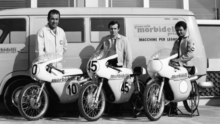It’s back in the black for Suzuki Motor America
Suzuki’s American subsidiary reports profitable first year
Eighteen months after buying the assets of American Suzuki Motor Corporation, the new Suzuki Motor of America, Inc. (SMAI) gathered its dealers to unveil new models, announce new programs, reinvigorate its network and prove that though SMAI is new, the company is rooted in a deep history.
In early October, SMAI hosted its first dealer meeting since American Suzuki dissolved its automotive business, and SMAI formed and took control of the powersports and marine segments of Suzuki in the U.S. The meeting, held at the Hard Rock Hotel in Las Vegas, was an opportunity for SMAI to show its current dealers what the company has been working on since April 2013, and to recruit new dealers into its network.
Though SMAI only recently formed, the Suzuki brand celebrated 51 years of selling motorcycles in the U.S. in 2014, and that history has helped propel SMAI to a successful first year.
“I’m proud to say that in the first year of our operation, we were profitable. That’s pretty remarkable when you consider all the upheaval we had — stopping the car business, employee loads and overheads,” SMAI vice president of sales and marketing Larry Vandiver told Powersports Business.

words for dealers at the Las Vegas dealer meeting.
Though the transition had its difficulties, Suzuki’s powersports and marine businesses have come out stronger.
“It allowed us to go back and focus on what our core business has always been here in the U.S., and that’s motorcycles, ATVs — of course those came a little later — scooters and our marine business. It allowed us to put our focus and our effort and all the effort of our corporation into making sure that this business runs,” Vandiver said.
Rebuilding a dealer network
When SMAI took control of Suzuki’s powersports segment in the spring of 2013, it did so shortly after American Suzuki had cut about 100 of its poorest-performing dealers, leaving the OEM with about 750 dealerships in its network. Since then, however, the company has been looking to regrow its network, with an aim of reaching 1,000 retailers.
“We did trim some dealers when we changed into a new corporation, but that was one of those necessary evils,” Vandiver said. “Now we’re rebuilding back in those areas, maybe not every one of those areas. For some of them, maybe the reason the dealer was having a hard time was it just wasn’t a big enough market. So it’d be unfair to put somebody else in there.”
SMAI has identified a variety of markets, including large metropolitan regions, where its competitors are succeeding, yet no Suzuki dealers exist. Though those are primary targets for growth, SMAI staff is talking to any dealer that has a strong business plan and isn’t within the territory of an existing Suzuki dealership.
“When I look at the markets, I think about 1,000 dealers is about right,” Vandiver explained. “Nobody’s stepping on each other, but you’re still covering the markets you need to cover.”
SMAI seeks dealers that can support the product and offer good customer service.
“A lot of the new dealers are really good, smart marketers and really enthusiastic, and I like that because it gives you a little shot in the arm,” Vandiver said.

Important to SMAI, and 37-year Suzuki veteran Vandiver, is working with the dealers so both the OEM and the dealerships can succeed.
“I think in business you have always got to be earning your stripes. If you’re not out there earning your stripes with dealers, then they have the right to kick you out. I think every day, every way, you’ve got to find a way to help dealers sell your product. You always have to be looking for how you’re going to do that as a company,” he said.
Dealer programs
To immediately improve its partnership with existing dealers, SMAI last spring began working to decrease dealers’ inventory, which had grown stale in many stores throughout the country.
“We created a really good program for our dealers to reduce all of their inventory, and not only just reduce it, but reduce it in a way that they didn’t have to take a loss; they could still make a profit,” Vandiver said. “That was important to us, and I think really important to dealers and important to the industry because it doesn’t look good for the industry when you’ve got three-, four-, five-year-old motorcycles sitting around. And besides that, it’s difficult for them to stock product or for us to bring new product if they’re sitting there on old product. That was one of our first moves was to reduce those inventories, which I’m happy to say we have.”
In addition to the inventory reduction program, SMAI has also worked with its finance partners, Sheffield Financial and GE Capital, to provide solid solutions to help dealers move both current and non-current inventory. In Year One, a number of those offers centered on 0-percent consumer financing, which many dealers praised.
“I’m a real big believer in turn, so every month we look at every day from last year to this year, and we design programs to help dealers turn more inventory, so they can turn profit on their end. That takes a lot of money on our end, and it’s difficult to make profit as a new company when you’re spending a lot on that, but you do have to make that commitment to the market,” Vandiver said.
SMAI has also partnered with Yoshimura to provide value-add muffler programs for the RMZ models and the GSX-R. And SMAI announced at the dealer meeting that it has committed $3.7 million in racing contingency for the upcoming race season, with a particular focus on amateur racing to grow its brand.
New models, lower pricing
Though many of the approximately 1,000 people representing 500 dealerships at the dealer meeting were there to learn about SMAI and its programs, all eyes were on the new and updated product.
Among the new models were the 2015 GSX-S750 and GSX-750Z and the V-Strom 650XT ABS. Suzuki also took the wraps off the early-release 2016 GSX-S1000. In total, 95 percent of the lineup has been updated for 2015.
Also drawing attention from the dealer body was lower pricing on nine motorcycles and four ATVs, which Vandiver said is designed to spur new unit sales.
“We’ve taken a look at the marketplace. We’re trying to attract new people to the marketplace. We’re sensitive to the fact that it’s still tough out there on a lot of people, so we lowered the prices. We’re in a position as a company that we can do that without hurting our profit margins,” he explained.
The goal was to bring the models that attract the younger crowd under $10,000, as SMAI has found younger buyers have a hard time obtaining financing for models over $10,000. Growing the powersports consumer pie, rather than just carving out a piece of the existing pie, is key to growth, as SMAI sees it.
“As a manufacturer, of course that has to be my primary worry all the time, but as an industry, we have to wonder why we’re not growing. We’ve decided after we looked at the past, some of the history of where bikes sold at what price point, we made this decision,” Vandiver said, adding that SMAI is price protecting current models as well.
Some dealers expressed disappointment over SMAI not releasing a side-by-side for 2015, however the OEM plans to first strengthen its core businesses and products before branching out.
“I don’t have everything everybody wants. Let’s face it, I don’t have a side-by-side, and that’s a growing, big part of the market and a lot of guys when we were changing thought [we would develop one], but I’m a motorcycle company and an ATV company, and I need to make that business as good as I can make it before I go off on something else. So that’s what we promised ourselves; we promised ourselves to build back in the motorcycle and the ATV business and the scooter business before we went out chasing other rainbows,” Vandiver said.
Renewed excitement
As dealers left the Suzuki dealer meeting, Vandiver was hopeful that they took home with them a fresh enthusiasm for the brand and a better understanding of SMAI and where the company is going in the future.
“I think what they’ll see is the new president [Tak Hayasaki] and a new enthusiasm all the way back to the factory to build the product and a company that’s looking for every area it can to make sales,” he said.
With SMAI already in the black, the OEM has its sights set on growth and improvement.
“We’re seeing the market come back a little bit,” Vandiver said, “so we feel like now is the time for us to make a move and rebuild back to our strengths of past years.”









what good are the new street models to Cal dealers if they dont meet C.A.R.B., seems like no effort was put forth to California dealsrs
If they are serious about growing their business in the U S then why don’t we have a side by side to offer in the sizzling off road business? Plus their ATV’s are way over priced compared to competitors.